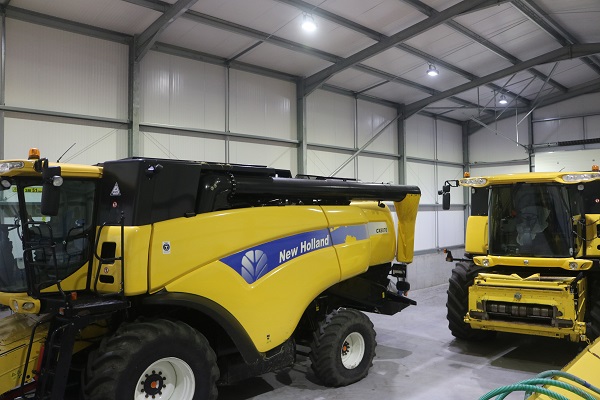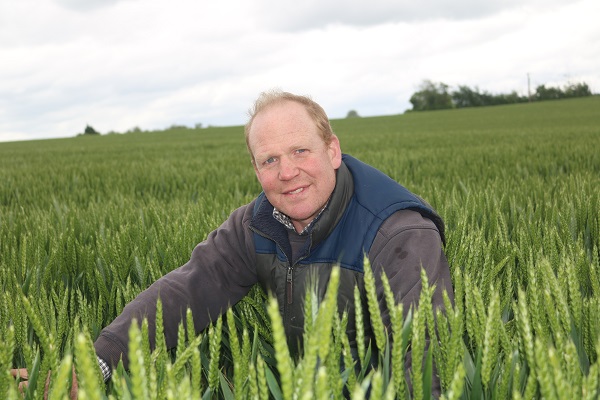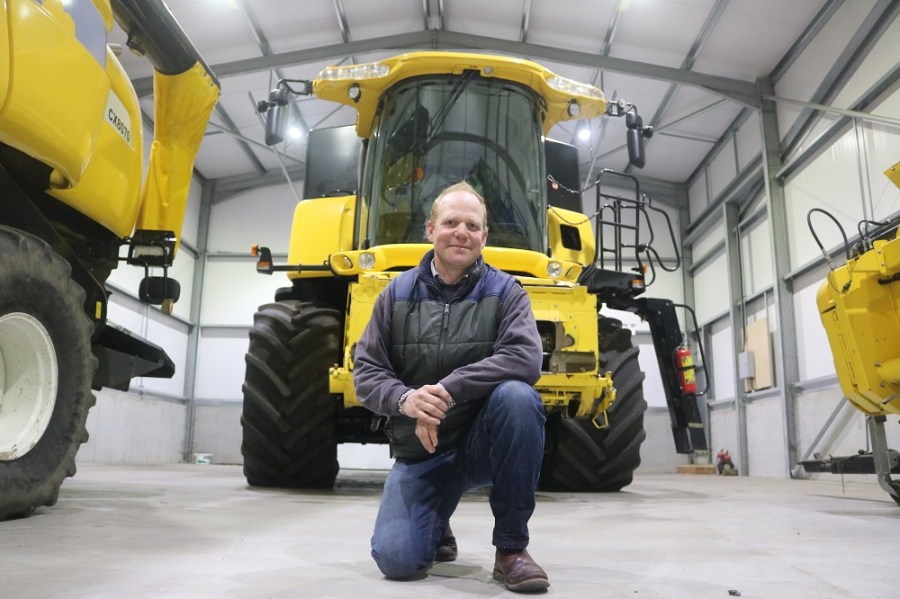Through joint-venture agreements, Bucks grower Antony Pearce has successfully slashed production costs. CPM pays a visit as a similar tight rein on input costs is put on trial.
The savings have been remarkable.
By Tom Allen-Stevens
If you’re fond of machinery, it’s quite a nice experience to enter the shed at Severalles Farm, flick on the lights and there are two fairly recent New Holland CX combines. But then with so much capital clearly tied up in metal, you wonder whether there’s a cool-headed resolve to streamline the business that lies behind the purchases, or a yearning for gleaming kit.
For Antony Pearce, there’s no question it’s the former. “Keeping two combines was an interesting decision when we came to make it. I was in favour of having just the one, but the partners in the business decided against it and we ended up with two. But I think it’s actually an illustration of a joint-venture agreement that’s working well.”

Joint venture
He’s involved in two joint-venture farming businesses. One is Landsman Farming, based at Moat Farm, Stoke Mandeville, Bucks, with 1200ha of mainly clay soils. Around 40 miles away near Burford, Oxon, Manor Farms crops around 860ha in total on Cotswold brash. Both ventures are members of Joint Venture Farming Group (JVFG) – a collaboration of 13 businesses that benchmarks costs with a view to understanding how to drive down costs per tonne.
With a business structure that works, and a solid grasp of fixed costs, now Antony Pearce has joined BASF’s Real Results Circle – a group of 50 growers coming together and sharing results from on-farm trials to find out what really works in the field (see panel on pxx). But he’s not sure the regime advocated will bring the best result.

The joint-venture businesses have allowed Antony Pearce to make “eye-watering” savings on machinery costs.
“I don’t think my farm has the potential to grow such high yields that it’s sensible to go for the high input, high output system. I’m more inclined to minimise the investment. But until you try it, you don’t know, so I’m keeping an open mind.”
Moat Farm is the operational base for Antony Pearce. It was bought by his grandfather and was itself an amalgamation of six mainly dairy and pig businesses. “In the 1980s, the expansion of Aylesbury gobbled up some of the farm and we used the proceeds to invest in 400ha in the Cotswolds.”
The two farms were handled as two separate businesses, with a farm manager based in the Cotswolds. “In 2004, we started sharing a combine with a neighbour – a Claas Lexion 580TT. Two years later, our manager retired, and that’s when we reviewed the structure.”

Antony Pearce doesn’t think his farm has the potential to grow such high yields that it’s sensible to go for the high input, high output system.
A totally new limited liability partnership was set up – Manor Farms. “It’s essentially a contracting business that owns all the machinery and one parent business supplies all the labour. The joint venture then bills the parent businesses for every bit of work it does.
“We had some professional input into setting it up and have formal partnership and management agreements. It cost a few thousand pounds to do this, but that’s nothing compared with the cost savings – these have been eye-watering. But then it obeys all the rules of a good joint-venture business.”
Clearly defined roles
He’s clear on what these are: “The characters in the business have to work. There must be clearly defined roles and responsibilities, and there should be equally matched finances. Size has nothing to do with this. But if you have copious amounts of capital, it seldom works to partner with someone who has lean resources. Likewise, a new paint addict rarely works well with someone who likes to run on rusted kit.”
With the success of Manor Farms, Antony Pearce looked to replicate the structure in Bucks. “My costs at Moat Farm were horrendous – there was a £400/ha difference between the two farm businesses.”
It was his agronomist, Andrew Cotton, who introduced him to Severalles Farm, owned by Nick Skipworth, an airline pilot who was looking to spend more time on long-haul flights. “An agronomist has a good insight on a business, and he could see it was a good fit. We set up a similar structure to Manor Farms, but this time it was a complete role reversal.”
It’s a partnership of three businesses: Stoke Farms, Antony Pearce’s home farm, already shared machinery with R&J Pearce, his father’s business, and then Severalles Farm. Antony himself is the managing partner and supplies the labour this time. “While the structure is similar, the Burford operation is beautifully simple, while Aylesbury is very complicated. But I think that’s down to the nature of farming across the two locations.”
One of the key areas of the business managed largely outside the partnership is the sheep enterprise – currently a 300-ewe flock, grazed partly on 60ha of permanent pasture and also across overwintered cover crops on the arable area.
“Sheep work well in an arable system, but you have to know their limitations. They’re selective grazers, so in a grass ley they’ll take the ryegrass in preference to blackgrass. After grazing, blackgrass lowers its heading height and you can still have problems with seed return.
Cover crops
“However, on overwintered cover crops, they’re brilliant. We establish a cheap cover based on oats, stubble turnips or mustard with an Autocast that’s shallow cultivated with the Väderstad Carrier. This encourages the blackgrass to chit and the green cover is grazed off from Nov to Feb. You get a much better result from spring cropping than from a two or three-year grass ley,” he notes.
The financial results from his businesses are pitched in with 11 others in JVFG and they meet three times a year, after autumn and spring establishment and for whole-year costing. “We all submit our data in an agreed format via a web-based system, and we’re quite competitive – it’s a bit like Top Gun.
“But the savings have been remarkable – we saved £16,000 at Manor Farms by dropping a tractor and moving to liquid fertiliser. We’d never have had the confidence to do it if it wasn’t for the experience of another member on the group.”
And he feels a similar approach to agricultural inputs, of cost saving, is the key to increasing profits. “Our farm average yields have varied from 6.5t/ha to 10.5t/ha, and I’m convinced that’s purely weather dependent. If I have a crop of Crusoe that’s holding up well, it’s weather that’ll affect it far more than any chemical addition.”
He hasn’t been involved in on-farm trials before, apart from investigating the establishment of beans. “It sounds well and good on paper, but it’s actually quite an undertaking and it’s only really been feasible since we could gather accurate yield data off the combine. All the staff must be involved so it’s managed correctly, and you must have the spare capacity to juggle things around. When you’ve a big area to manage, the one thing you don’t have is time.
“But as margins continue to be squeezed, if you’ve taken out the costs as we have, the only way to improve profitability is to increase productivity. Do I think my cheap and cheerful reliance on resistance ratings will be beaten by the high input, high output approach? I doubt it, but until I’ve tried it on my own farm, I won’t know.”
Clean crop puts spray programme to the test
With the T2 spray now applied and the crop fully out in ear, Antony Pearce’s crop of Crusoe looks as though it has real potential. The 30ha field – with Prime Minister’s residence Chequers just over the hill – is a medium chalk and was drilled on 7 Oct, following spring beans.
“The crop’s clean, but then it’s been a low disease year. I wouldn’t say there’s any noticeable difference between the two strips, although there were two days between the T1 applications. The weather on the day we sprayed the farm programme resulted in a bit of scorch. But the whole crop looks healthy now,” he reports.
Moat Farm is among 50 farms that have joined the Real Results Circle – an initiative that will allow farmers to conduct their own on-farm trials, backed by BASF.
Four tramlines have been set out, and these are being monitored and assessed throughout the season by ADAS and AgSpace, who are providing technical support and helping Antony Pearce apply a reasonable degree of scientific rigour to the trials.
The crop assessments will be made using the Agronōmics system, says ADAS crop physiologist Susie Roques. This is a new digital technique for farm-based research developed by ADAS and AgSpace with the support of the British Geological Survey.
“The Agronōmics approach brings a new and unique scientific credibility to the design, management and statistical analysis of tramline trials which will ensure that the 50 participating growers can have more confidence in the results than they would ever have had before,” she says.




